Taking advantage of free miles, on 5 January, my husband Elwin Wirkala, together with a friend and myself flew to San Diego. That same afternoon we crossed the famed border between the haves and have-nots, or, as our Tweeter-in-Chief would say, the border between criminals, rapists, drug traffickers, terrorist, mafiosos and who knows what other riffraff is invading our country.
So we were walking the vibrant Tijuana downtown near the iconic and monumental Clock Arch on the Avenida de la Revolución pulling suitcases with around 100 books in each which we aim to distribute to the children of the criminals, rapists, drug traffickers, etc. To our surprise, we did not meet a single one of these malignant personages and we arrived unscathed back at our hotel.
There, what we had heard was confirmed: a large part of the caravan of these criminals and other scum had already dispersed. Of the 7000 individuals who left Central America in October escaping violence and poverty with plans to cross the “line” and ask for asylum, they were only some 2000 left in Tijuana. Some had fallen by the wayside in the course of their long journey. Others, rejected by the officials of Homeland Security and deported, where on their painful return to their countries. Many others accepted the generous offer of the Mexican government to remain in that country and receive a work permit. Some feew, we were told, had taken the bull by the horns and sought illegal entry more to the east, climbing over the fence or trying to dig under it, where it exists, or risking their lives crossing the desert. (If they survived, they have surely been picked up by ICE by now.) The rest, those who still nourished the hope of a legal crossing, of being heard and accepted into the United States, had already been transferred to a new immigrant center on the outskirts of Tijuana called El Barretal, the first shelter having been closed down by the health authorities.
Armed only with our children’s books, we went to face the terrible mob in El Barretal. The military police charged with keeping order there received us with undetectable enthusiasm. Our guide told us not to deliver the books directly to the families, as was our intention, but to leave them for Global Vision volunteers who, next-day, were coming to organize activities with the children. They also forbade us from taking pictures of minors. Since no one is his right mind could argue with these guardians of the public well being, we left the first suitcase in Reception as instructed.
The guide showed us the facilities and explained that various organizations are busy providing food and health services to the migrants, who receive four and even five meals per day. “They are super well-fed,” he said. The shelter consists of a large cement patio where single man camp in an orderly file of tents, plus a pavilion which was formerly used as a dance floor of ill fame and which now shelters families, each one with a small tent. In vain we looked for the threatening faces of assassins and criminals. We only saw a large group of humble people, hopeful and thankful for the Mexican government’s help offered.

As it was January 6th, Día de Reyes, a group of seminarians had arrived and a Bach chorale could be heard, giving the place a festive and religious air. Immediately afterwards the event of the day was announced. A pair of young clowns drew an audience of children and began with a very Latin and quite sexy dance which provided great joy to the children and, perhaps, the seminarians. Mothers took pictures of their young. Naturally, they wanted to have a memory of their stay in the limbo of El Barretal, so distant from their homes and so near the illusory Paradise. We know that only about 9% of asylum-seekers actually gain asylum. Did they know this? I didn’t have the heart to ask them.
In the afternoon we walked to our second destination: a clinic managed by the American NGO The Other Side. There we left our second suitcase full of books. Around 20 kids visit the clinic on a daily basis, we were informed, and a small children’s library will be set up in the waiting area.
The following day we visited another shelter in the North Zone, a neighborhood well-known for its mini skirted girls with high heels and for the drug traffickers who roam its streets. In this shelter, organized by a local NGO, “The Ambassadors of Jesus 2000”, or some such, received us with little sympathy. The door guard seemed reluctant to open it, and when he did, he prohibited any pictures of the minors. A little one came up to me and asked for a book on dinosaurs. I did not find one, but he was satisfied with another one, about astronauts.
Here also the migrants, all families in their tents, seemed well fed. A recently-arrived teary-eyed Honduran couple told us how a gang had burned their house and killed a family member for not having come up with the monthly payment required of his small business. This type of extortion is common in a country where law doesn’t practically exist and the government doesn’t govern. The man had documented his complaints with the authorities. This will, perhaps, giving a right to asylum. But perhaps not.

As we were conversing, my husband took various photos and videos and the door guard ordered him to erase them. He did not. An anarchist with regard to rules he thinks absurd, he put his phone back into his pocket and left the place abruptly; and we followed. The guard phone the police or at least said he was doing it. At this point our friend, who grew up into Tijuana and said she knew her people, their neighborhoods and the police, urged us to pick up the pace, murmuring something about the North Zone, Mexican federal jails and other horrors. As we made haste to the main street and got into a taxi, a police car came around the corner.
That same afternoon, our friend left for the airport and Seattle. Elwin and I went to Lo Algodones by bus, crossing the extraordinary stone mountain geography called La Rumorosa. As if a divine but eccentric Architect had thrown numberless stones here and there which fell one atop the other in great rock piles of the strangest forms, La Rumorosa is part of a continuous geographical phenomenon on both sides of the border. It is unthinkable that a human being could cross such a mountainous rock pile. However, when days afterwards we returned in the opposite direction on the Arizona side, several patrol cars were stationed beside Highway I8 on the alert for the appearance of some unlucky undocumented migrant.
After our appointment in one of the 350 dental clinics in Los Algodones, we took a rental car to our last stop, San Luis Rio Colorado, in the State of Sonora.
Having heard of a caravan of migrants from Central America, poor families from Guerrero and Chiapas also decided to embark on the same adventure and, walking 50 km per day, they arrived at this port of entry. There was also a group of Cubans who had decided to try their luck. We walked on a street parallel to the “line”. The sidewalk was festooned with tents and other improvised shelters consisting of tarps, plastic, string and sticks. There is no government aid in evidence. We were told that the Catholic Church sometimes provides food. These people were organized themselves by themselves. They kept the sidewalk clean and each family or individual that arrives receives a number which they immediately give to the authorities “on the other side” who? will keep track of access over the pedestrian walkway. We counted about 70 families and some 150 children. There they live day and night, paying attention to the numbers called. The announcement is made only twice a day “in order to avoid confusion”, a border official explained. At that rate, the final travelers would wait at least a month before being called. It is most probable that their requests will be rejected. They, however, seem not to know this, because those who are called enter through one place and are deported through another, after a few days of detention by Homeland Security.

The children of San Luis Rio Colorado received in the remainder of the books. They approached respectfully with their parents, then made their books selection from the open suitcase. They then disappeared into the tent and plastic caves with their little book under their arms while the parents thanked us with heartbreaking humility. No one asked us for money.
Their lives are also in limbo like babies who die unbaptized, according to Catholic legend. But this earthly limbo must be worse than the celestial variety. Here it seems that God has forgotten them. Or perhaps he has made a pact with the followers of Trump.
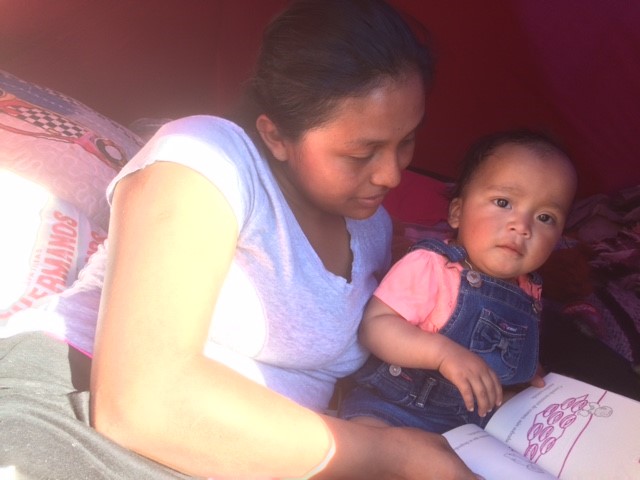
Summing up, this is the “great border crisis”. These are the criminal hordes, the mafioso rapists, terrorists and other low-life’s who threatened the territorial and cultural integrity of the United States of America according to our Great Leader. These several hundred innocent families, with their runny-nosed babies in their arms, with their incredibly candid naivety believe that the doors of the Colossus to the North will be open to them by dint of the fact that they are poor.
We left, satisfied and sad. Satisfied for having seen some little happy faces of children turning colored pages with numbers, animals, witches, grandparents. Sad because we know that the majority of them will not have the opportunity to realize their most modest dreams.





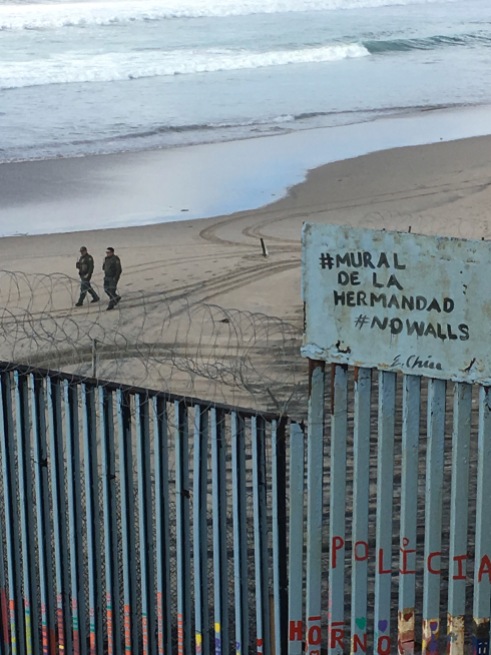



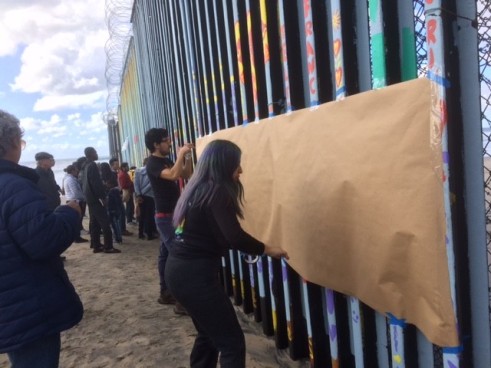

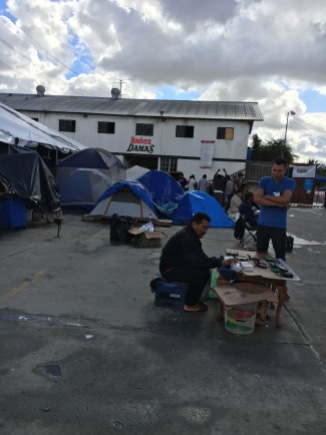

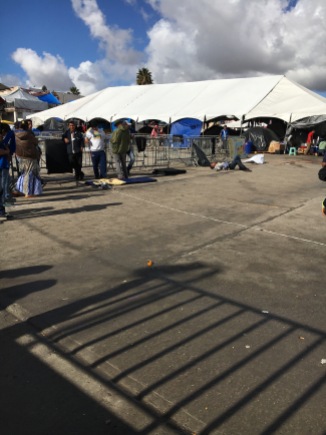



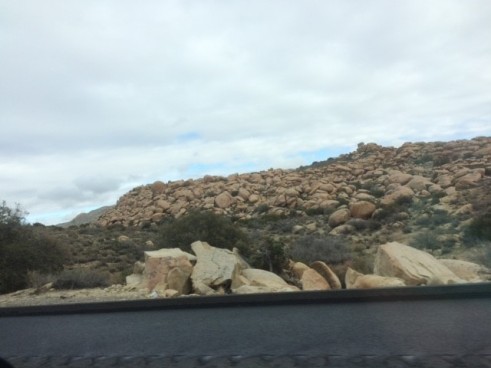





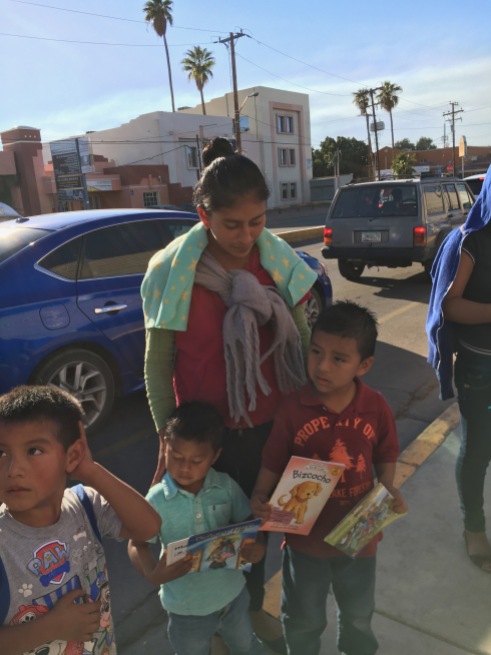

Gracias Rita! Me gusto mucho…
y gracias a ti y todo el club de espanol por el apoyo y las donaciones!
Nice Work Rita!
Thanks for reading it, Sharilyn!
Impresionantes las fotos,Rita!!
Sobre todo cuando el muro se mete en el agua…!!
Thank you Rita for give us a more real version or what is going on at the border I praid every day for them and the children that are separete from the parents
Gracias Rita por este reporte de primera.
Qué inspiración saber lo que hicieron!
Gracias a las donaciones de todos ustedes Mary Ann!
Y gracias a uds. los donantes de libros!
Queridos Rita y Elwin, gracias mil por traerme de “colada”, las fotos y la manera de relatar lo vivido y la angustia de estas familias es impresionante. Les mando un abrazo!
Pingback: El Encuentro/The Encounter, A Review – Latinx Talk